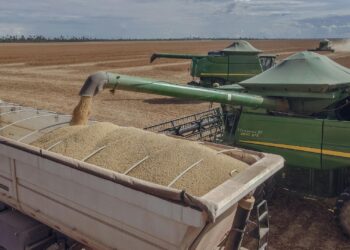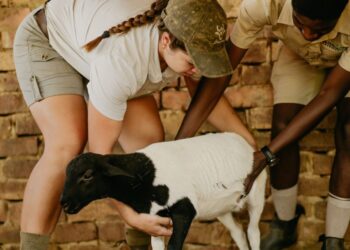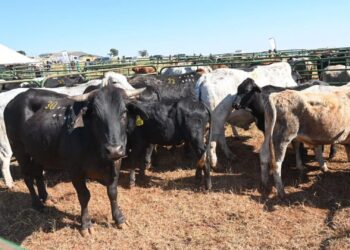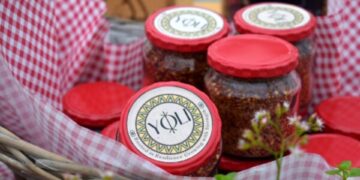SA agriculture is seeing a surge in female graduates, but the climb to equality is steep. Women are still concentrated in admin roles, and pay gaps persist. Duncan Masiwa and Adam Oxford dissect the data, highlighting the urgent need for pay equity audits and stronger support for female professionals.
Agriculture in South Africa is under pressure to modernise, attract talent and retain skilled workers. Although the sector is seeing a growing inflow of female graduates, suggesting the next generation of professionals could be far more gender balanced, persistent pay inequities and outdated thinking threaten to derail this progress.
Data from StatsSA’s Quarterly Labour Force Survey (QLFS) paints a depressing picture. As shown in the chart below, the agriculture sector is estimated to employ around 60 000 more people today than in the first quarter of 2008, but the share of jobs which go to men has increased.
Around 100 000 more men are employed in the sector, and 40 000 fewer women.
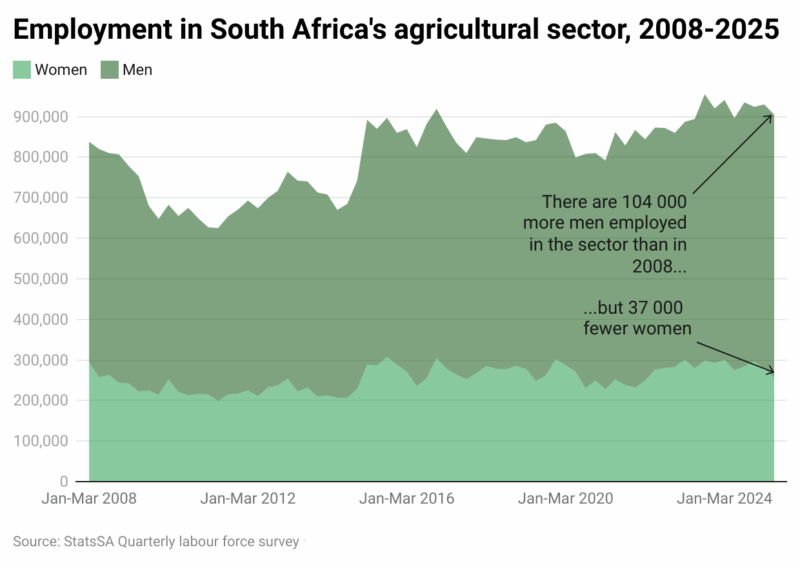
According to Marianne van der Laarse, CEO of Agijobs, recruitment specialists in the agriculture sector, more women have studied agriculture and applied for entry-level roles over the past five years.
“More females are now entering the agricultural workspace, particularly in office-based roles or positions that combine office and outdoor work. However, traditional outdoor roles or those involving extensive travel still see more male applicants,” she says.
More women entering farming
Agijobs is actively involved with graduate placements, including initiatives on behalf of the Fresh Produce Exporters Forum (FPEF). In a 2025 study, the company examined all graduates placed between January 2017 and March 2025.
“During this period, Agijobs placed 58% females and 41% males in roles typically found in the fresh produce export industry, like packhouse operations, food safety and quality assurance, logistics, data processing and IT, export administration. This supports our observation that more females are entering the agricultural value chain,” Van der Laarse adds.
Mpho Sekati, sustainable agriculture specialist, says he is inspired by the growing number of women who are taking the reins in farming.
“According to recent statistics, women own 20% of farming units in the country, a significant increase that indicates a shift towards a more inclusive and diverse industry. This trend not only challenges traditional gender roles but also brings a unique perspective to agriculture, driving innovation and creativity,” Sekati says.
Related stories
- Women who farm, lead, and grow the heart of Mzansi
- ‘One woman, one hectare’: Farm women demand land rights
- Farming’s future demands women at the table, says Naidoo
Sekati emphasised the importance of supporting and empowering women in agriculture by ensuring they have access to the necessary resources and training to thrive in the sector.
He highlighted the need for collective efforts to strengthen support for women farmers and to build a more equitable and sustainable food system.
However, according to the QLFS, men make up the vast majority of workers in nearly every agricultural occupation, particularly in elementary occupations, plant and machine operators, and skilled agricultural and fishery work.
The only occupation where women outnumber men is clerical work. This indicates that women are concentrated in administrative roles within agriculture rather than in field or technical jobs.
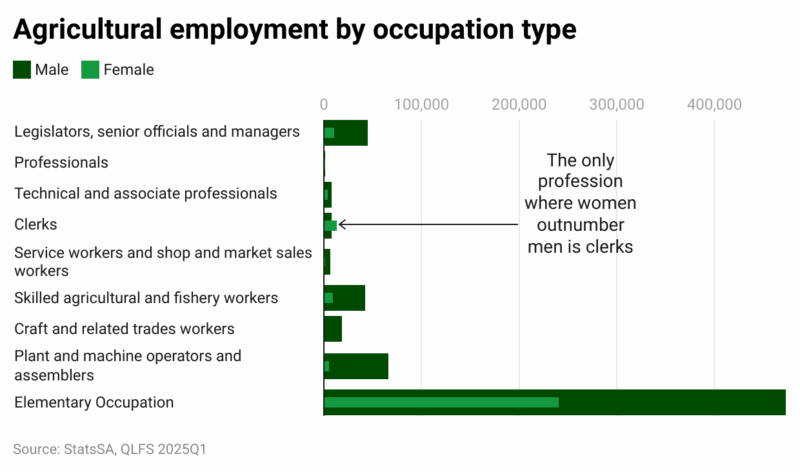
Top management still a male stronghold
These ratios are relatively unchanged in recent years. A 2020 study on women in agriculture, conducted by The Sustainability Initiative of South Africa (Siza) in collaboration with the Western Cape department of agriculture, found similar insights into gender representation across the horticulture, livestock, field crops, and mixed farming sectors in all nine provinces. The study collected responses from 192 Siza members through an online questionnaire.
Findings show that the majority of women in agriculture, 93%, are employed as general agri-workers. Most respondents expressed a preference for hiring women and affirmed that women are eligible for any position within the business. However, barriers such as limited education, insufficient training, and a lack of confidence among women themselves were noted as challenges to their advancement into higher positions.
The research also indicates:
- 4% are supervisors
- 1.5% are senior representatives
- 1% in farm management, and
- 0.5% in top management.
Female general agri-workers, farm managers and supervisors increased from 2007 to 2018. An increase from 15% to 26% of female supervisors was reported nationally.
In administrative roles, male employees increased from 2 891 to 4 739, while female employees grew by 2 609, reflecting a steady but slower increase in women’s participation in administrative positions.
Women in science, innovation & agro-processing
According to Van der Laarse, Agijobs has observed a noticeable shift in gender dynamics within agricultural recruitment over the past few years. Traditionally male-dominated sectors such as agronomy, farm management, and mechanisation are gradually seeing more female applicants, although men still make up the majority in these roles.
“Interestingly, we’re seeing strong female representation in areas like food science and food technology, processing sustainability, and agri-processing – fields that blend science, innovation, and impact. Women also tend to apply more for roles in marketing, HR, and community engagement within agri-businesses, where communication and stakeholder relations are key,” she explains.
Another encouraging trend, Van der Laarse shares, is the rise in female graduates from agricultural faculties across South African universities. This, she believes, is translating into a more balanced applicant pool, especially for internships and graduate programmes.
“While there’s still work to be done in breaking down stereotypes and ensuring equal access to opportunities, the momentum is positive. We believe the future of agriculture will be shaped by inclusive talent pipelines – and we’re proud to be part of that transformation.”
Marianne van der Laarse
Omnia field agriculturalist Izane Crous, agrees that while agriculture has traditionally been male-dominated, this is starting to change.
“Women bring unique skills, perspectives and experiences to the agricultural industry, driving innovation and creativity. A diverse agricultural workforce fosters inclusion, empathy and better problem-solving,” says Crous.
As technology-driven solutions for efficient crop management are becoming more popular, this is opening up more roles for women.
“Some of the most promising career paths for young people in agriculture lie beyond the farm gate,” says Crous. “We’re seeing a growing need for professionals who can bridge science, business, and innovation to secure the future of our food systems.”
These careers include agricultural economist, agricultural educator, precision agriculture specialist, agricultural research scientist, and food scientist and food safety specialist.
“By employing the best person for the job, regardless of gender, we can achieve better productivity and sustainability in the agricultural sector,” Crous adds.
Gender pay gaps persist despite progress
When it comes to salary pay gaps, Siza’s research found that the majority of managers and supervisors are paid above minimum wage and industry benchmarks. Nevertheless, female managers and supervisors still trail behind, with fewer women earning above these benchmarks.
“For general agri-workers, the data shows a more balanced picture. However, more women than men are reported to earn only minimum wage, while more men than women are paid above minimum wage. This may be due to the pervasive perception that men are the breadwinners in the family,” the research found.
Stats SA publishes salary data in its annual Labour Market Dynamics report, which breaks down earnings according to profession, high level occupation classification and salary bands. Using these numbers, Food for Mzansi estimated average salaries for male and female workers in the sector.
Using these calculations, women can expect to earn less than half that of their male peers across most occupations, although there may be variations based on levels of seniority that we are unable to account for.
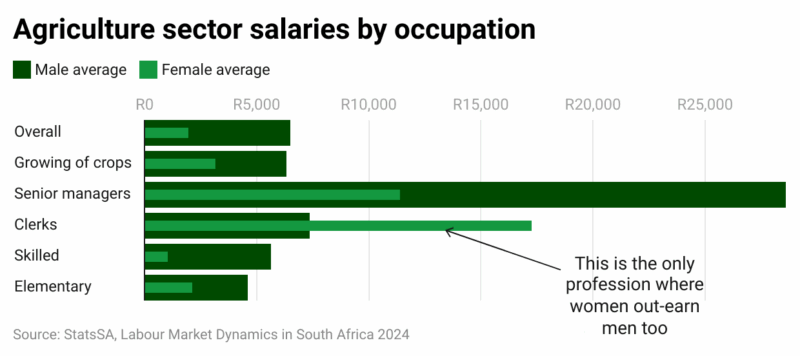
The same data also suggest that the wage gap has increased dramatically since 2016, except for in the one area where women are able to out-compete men, clerking. While women continue to earn more than men here, the gap has actually shrunk in favour of male earnings.

While these numbers reflect official statistics, they may not be fully representative, and tracking real earnings is difficult.
Van der Laarse points out that it is difficult to have full visibility into internal salary structures, especially in private sector roles. However, they do see encouraging signs of growing parity, particularly in structured graduate programmes, internships, and roles within larger agri-businesses that follow formal HR policies.
“In these environments, salary offers are typically based on role requirements, qualifications, and experience, rather than gender. However, disparities can still arise in negotiation outcomes, especially in mid- to senior-level positions. Research and anecdotal evidence suggest that women may be less likely to negotiate aggressively, which can impact starting salaries and long-term earning potential,” she explains.
The road ahead
Van der Laarse says Agijobs actively encourages employers to conduct regular pay equity audits and ensure transparency in their recruitment processes. Likewise, they support candidates – especially women – with guidance on salary expectations and negotiation strategies to help close any gaps.
“Ultimately, while progress is being made, true equality requires ongoing effort from both employers and recruiters. We’re committed to playing our part by promoting fair hiring practices and empowering all candidates to be attentive, informed, and realistic,” she concludes.
This article is a collaboration between Food For Mzansi and OpenUp, supported by Africa Data Hub.
READ NEXT: Wieta pushes for black wine brand transformation




